Wake-Up Westchester! Why people need to band together to stop DAS rollout NOW
- Details
- Hits: 9475
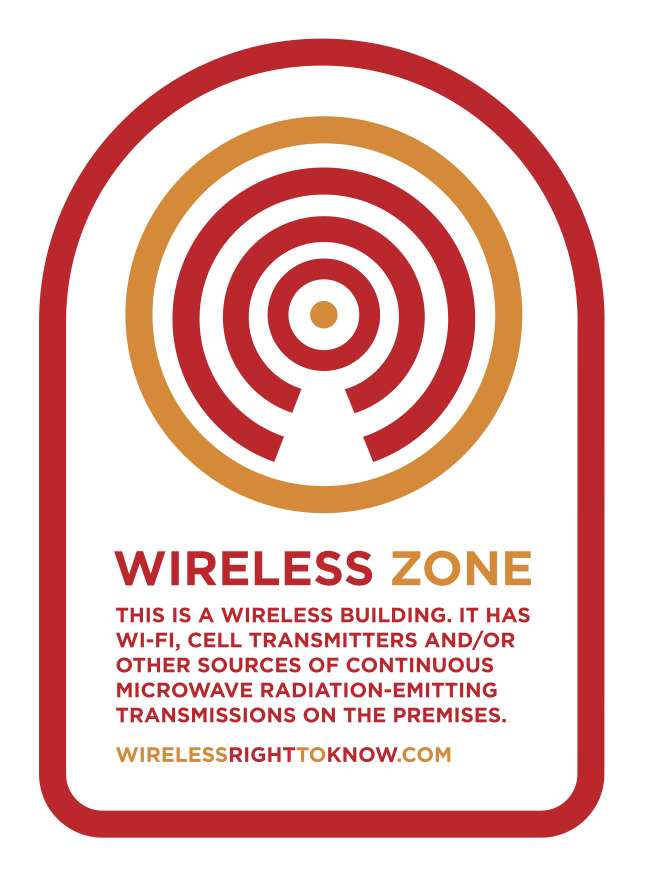 Here is a letter to Scarsdale10583 submitted by Deborah Kopald, a nationally recognized public health advocate, who will be discussing DAS (and how to stop it) as well as other wireless transmitters and devices on Wednesday, February 29th from 7:30-9:30 p.m. at Wainwright House in Rye.
Here is a letter to Scarsdale10583 submitted by Deborah Kopald, a nationally recognized public health advocate, who will be discussing DAS (and how to stop it) as well as other wireless transmitters and devices on Wednesday, February 29th from 7:30-9:30 p.m. at Wainwright House in Rye.
In 1993, the California Public Utilities Commission (CPUC) recommended that cell towers be placed away from schools and hospitals. A few years later, 40 scientists at the Harvard and BU Public Schools of Health called cell towers a public health emergency. Those following these developments would have been hard-pressed to wonder whether the CPUC recommendations shouldn’t also apply to residential zones and areas that people frequented and worked at. There was reason for concern—the literature on people living near radar, tv and radio towers showed negative health consequences to those in close proximity; cell towers represented the first time that the population at large would be exposed ubiquitously and continuously to microwave radiation.
In the intervening years, many forward-thinking municipalities structured ordinances that stipulated that cell towers be kept away from homes and schools and placed in industrial areas before residential zones in the name of protecting property values (since the Telecom Act of 1996 prevents regulation on the basis of radiation emissions and health effects). Literature conducted on health effects of cell towers has indeed borne out what was feared; those in proximity show elevated rates of negative health- from sleep problems, to cardiovascular dysfunction to cancer. The movie Full Signal chronicles the health problems of those living close to transmitters around the world.
Since the prescient CPUC recommendation, at least 15 countries or international bodies have issued advisories on wireless devices and/or transmitters. Israel bans new transmitters from residential areas and has put a moratorium on the 4G network. Some governments have warned citizens not to abandon their landlines, to hold cell phones away from heads and bodies when not in use, to restrict children’s use of cellphones and not to install Wi-Fi. Independent scientists assert that cellphones are linked to brain tumors, brain damage, and cognitive dysfunction and that being in close proximity to a wireless transmitter regularly is also a problem, especially for children whose brains, eyes, immune systems and other organs are more susceptible to the effects of microwave radiation than adults’.
Obviously holding a cell phone to your ear is usually the most intense exposure people receive at a given time—although sitting next to a very high powered Wi-Fi transmitter on public transportation can expose you to the same amount of radiation as talking on a cell phone. But a 2009 Swiss study showed that people in urban areas were getting more cumulative radiation from moving in and out of areas with transmitters than they were getting from daily use of their cell phone. In other words- radiation exposure from Wi-Fi exposure in school will exceed most children’s cell phone exposure over time. In any event, we do know that the levels of Wi-Fi in many schools are as high as if there were a cell tower on the premises and the levels working at Wi-Fi enabled laptops are even higher.
Meanwhile, technology continues to be rolled out at a pace that outstrips our ability and willingness to regulate it, the distinction between a device and a transmitter is increasingly collapsing, and the radiation in peoples’ homes, work and schools is increasing as the microwave radiation-emitting transmitters are placed closer to areas that people spend time in and higher powered devices are perched on people’s laps- or at least at their desks or on their bed-side tables.
Wi-Fi, smart meters (devices placed on the side of homes by utilities to measure electricity that obviate the need for meter-readers) and portable hotspots—even the use of wireless devices on trains (where the metal structure magnifies the effect of the radiation emitted by so many people using their wireless devices simultaneously in an enclosed space) – exceeds the amount of radiation people were exposed to by most of the cell towers that have been rolled out in the last 15-20 years. Since radiation exposure is more a factor of proximity than total power output, what happened between early attempts to site cell towers responsibly to the current explosion of in-building radiation systems and devices that produce radiation exposures well in excess of the amounts people are exposed to from cell towers (and were right to be concerned about)?
Even the cell towers are being placed closer in closer- on utility poles right outside peoples’ homes. This has occurred all over California (often in neighborhoods with multi-million dollar homes, in Long Island, and is starting to happen in Westchester, especially in communities with weak transmitter-siting ordinances on the books. The cell transmitters-on-poles phenomenon, known as DAS, or Distributed Antennae Systems, are exposing more people to more radiation in their own neighborhoods than they were ever exposed to by most cell towers due to transmitter proximity.
Expensive neighborhoods are no longer a refuge from an effective occupational exposure to microwave radiation. This is outrageous, and people need to stand up and fight DAS comprehensively before it affects their individual street or neighborhood. The Telecom Act of 1996 promotes ubiquitous phone coverage, which has generally been achieved. Nowhere in the text does it guarantee corporations the right to ubiquitous coverage of so-called “enhanced services” so iPhones and their ilk can receive high-speed data transmissions in every nook and cranny. There is a reason why Israel put a stop to 4G; that country fears the radiation emissions are problematic for public health.
High speed data should be transmitted by wire, and people and institutions should be encouraged to connect via wire indoors. What is the marginal benefit of being able to do heavy computing in your basement or yard, when you could do it at a wired computer in your home office with no exposure to microwave radiation? People need to ask themselves this question- if not for themselves, than for the sake of creating a safe environment for their children. Because the federal government will not take steps to protect public health in this country (while Europe has done extensive studies, our government cancelled studies they did with industry in the 90’s that were showing extremely negative health consequences of microwave radiation and then issued less-reliable animal studies in 1999 that didn’t get started until 2010 and won’t be completed before 2014), people need to work with municipal officials and state regulatory bodies to question the appropriateness of DAS and put a stop to it before it becomes ubiquitous. Any less means the loss of the right to control the levels of microwave radiation in one’s own home.
In other words, the failure to speak out means people are handing rights over to the wireless industry that they are not necessarily entitled to. If people do not rise to the occasion, and DAS is allowed to become ubiquitous, it will be harder to stop it and subsequent proliferations of other transmitters that will expose people to even higher levels of radiation.
Consider: the EPA Radiation Protection Division stated that no standards exist for long-term exposure to microwave radiation. The Federal Interagency Working Group on Radiofrequency Radiation states that the standards for pulsed radiofrequency are NOT protective of human health. But the agencies tasked with standards setting, health review and public advisories are paralyzed by bureaucratic inaction.
The rollout of DAS is an unprecedented power grab by utilities; since the pulsed microwave radiation coming out of transmitters is odorless, colorless and tasteless, most people are not aware there is a serious issue afoot. Many of those that do realize the magnitude of the issue make a feeble protest effort when it is too late and the contracts are practically signed. Meanwhile, the EU and the Council of Europe have called effectively for transmitter-free zones in and around schools, hospitals and old-age homes.
Perhaps Winston Churchill was wrong when he said “America eventually gets things right after exhausting all the other possibilities”, because while we should be addressing failed public policy that already exposes people to unacceptable and uncontrolled levels of radiation, we are in the process of increasing our exposures further. People should not wait around for a pronouncement by the U.S. government but take immediate action at the local level.
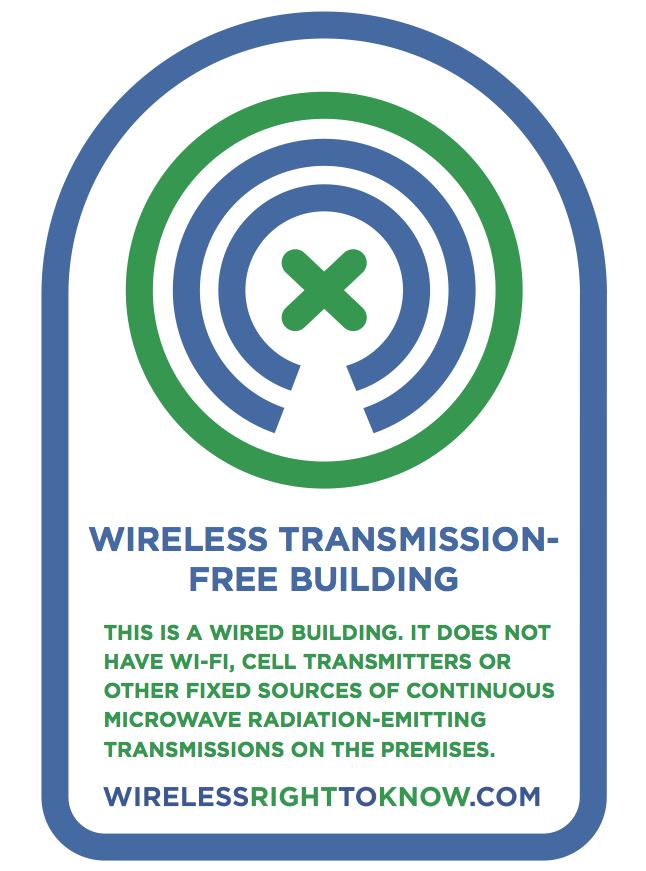 Editor’s note: A decal such as the one at right may someday indicate buildings free of wireless technology, while the decal on the top would indicate that a building contains wireless transmitters.
Editor’s note: A decal such as the one at right may someday indicate buildings free of wireless technology, while the decal on the top would indicate that a building contains wireless transmitters.
Letter to the Editor: Developer Dupes Village
- Details
- Hits: 3820
To the Editor: 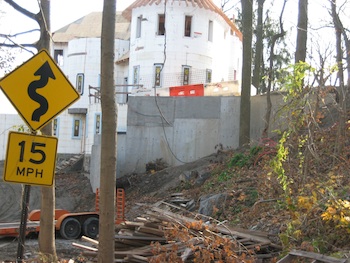 Regarding the recent article relating to the home built in Saxon Woods by a developer that received a pass by the Boards and Building Department of Scarsdale we here in Edgemont are experiencing the same lack of enforcement and regard for our home and existing neighborhood.
Regarding the recent article relating to the home built in Saxon Woods by a developer that received a pass by the Boards and Building Department of Scarsdale we here in Edgemont are experiencing the same lack of enforcement and regard for our home and existing neighborhood.
The owner/builder (who is actually in telecommunications and not a builder by profession) purchased the lot on 201 South Healy Avenue and is attempting the same "duping" here in the town of Greenburgh. The builder received a permit to build a modest one-family residence on a small lot which he has, without permit or approval, substantially increased in size and scope and moved structures and walls all without going before the boards for permission to deviate from the approved plans. Depending on the day, the home is either for his family or for sale - it has been on and off multiple listings.
He has harassed us regularly for almost two years, damaged our private property, towed my car from my driveway while we were away on vacation, made verbal threats, thrown my garbage can every Monday and Thursday for three months, threatened my wife twice with his construction vehicle and dumped dirt on my wife's head with his bobcat from behind. At a recent meeting of the Zoning Board of Appeals he slapped a female neighbor in the face and was arrested. He is aggressive and violent towards us because we are documenting his unlawful building and trying to get the town to see what he is doing.
What is the point of land use Boards and Building Department inspectors? Apparently you may now purchase property and build whatever you want? Why aren't these boards and town officials enforcing the 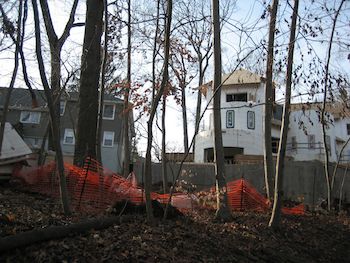 laws and codes in place to protect existing property owners and neighborhood integrity? Why must the existing homeowners police the builders? And why after issues are brought to the town's attention are they ignored? We have supplied an enormous amount of documented proof that what is being constructed is not what was approved and yet while the town spins their wheels, he continues to build...now he is claiming financial hardship because instead of being stopped when it was a mere foundation, he has been allowed to continue at "his own risk". So he has continued, banking on the idea that now that so much has been built, the town won't make him take it down.
laws and codes in place to protect existing property owners and neighborhood integrity? Why must the existing homeowners police the builders? And why after issues are brought to the town's attention are they ignored? We have supplied an enormous amount of documented proof that what is being constructed is not what was approved and yet while the town spins their wheels, he continues to build...now he is claiming financial hardship because instead of being stopped when it was a mere foundation, he has been allowed to continue at "his own risk". So he has continued, banking on the idea that now that so much has been built, the town won't make him take it down.
There is no reason why any of this should be happening, yet it is; and although we are disgusted that we have had to endure this man's reign of terror, we will not be bullied and allow our home to be devalued nor allow his constant threats to deter us.
If we don’t take a stand then all of you should be prepared should something change next door to you.
Mark Gordon
13 Elizabeth Street
Scarsdale, NY
Caught in the Crossfire
- Details
- Hits: 3307
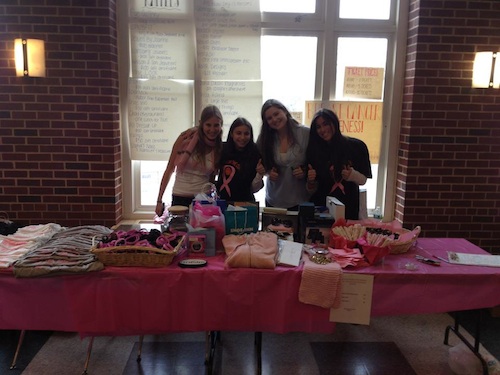 Members of the Breast Cancer Club at Scarsdale High School were caught in the crossfire last week when they held a fundraiser in the wake of the controversy about the Susan G. Komen Foundation and Planned Parenthood. Club Presidents Danielle Berger and Rachel Brief were in the midst of planning the February 4th Breast Cancer Awareness Day at SHS when the news broke that the Susan G. Komen Foundation would no longer fund Planned Parenthood.
Members of the Breast Cancer Club at Scarsdale High School were caught in the crossfire last week when they held a fundraiser in the wake of the controversy about the Susan G. Komen Foundation and Planned Parenthood. Club Presidents Danielle Berger and Rachel Brief were in the midst of planning the February 4th Breast Cancer Awareness Day at SHS when the news broke that the Susan G. Komen Foundation would no longer fund Planned Parenthood.
At the time, members of the club were in the process of soliciting local merchants for contributions for their raffle and found that some refused to donate because of the news. Though traditionally 100% of the proceeds from the event had been donated to the Susan G. Komen Foundation, this year, even before the controversy, the girls had decided to divide their donation between Komen and GOPiNK.
The Club proceeded with their sale of baked goods, bracelets, breast cancer pins and tickets for the raffle items they could get and held their sale during the game against Port Chester. The reaction that got to the raffle solicitation paled against the hostility they received from the crowd at the game. Berger was totally taken aback by the comments the sale incited, with some yelling at the girls and manyrefusing to support their efforts. The girls learned how passionate, and rude, the community can sometimes be.
They proceeded with the fundraiser but did not earn as much as they had in previous years – which could be attributed to the uproar over Susan Komen or to the fact that the Varsity game against Port Chester was not a big draw.
Pictured above: Danielle Berger, Jamie Kaplan, Jenna Karp and Rachel Brief
Scarsdale Forum Celebrates Friendship
- Details
- Hits: 3247
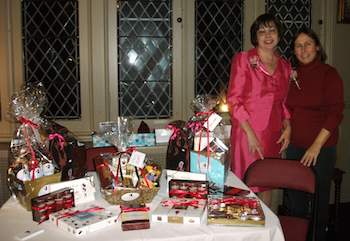 The Scarsdale Forum's fourth annual membership party was a celebration of friendship set within a Valentine theme on Saturday night February 11 at the Scarsdale Woman's Club. The food and beer stations were hopping all night, the jazz trio set the mood, the boutique and raffle were attractions for many and there was quite a number of guests who stopped by the artist alcove to be sketched. The cozy feel of the dessert room where members and their guests enjoyed many home baked treats was a fitting end to a wonderful evening made possible by many volunteers of the Scarsdale Forum. (Pictured at left: Forum President BK Munguia and Lena Crandall at Imagine Candy boutique table.)
The Scarsdale Forum's fourth annual membership party was a celebration of friendship set within a Valentine theme on Saturday night February 11 at the Scarsdale Woman's Club. The food and beer stations were hopping all night, the jazz trio set the mood, the boutique and raffle were attractions for many and there was quite a number of guests who stopped by the artist alcove to be sketched. The cozy feel of the dessert room where members and their guests enjoyed many home baked treats was a fitting end to a wonderful evening made possible by many volunteers of the Scarsdale Forum. (Pictured at left: Forum President BK Munguia and Lena Crandall at Imagine Candy boutique table.)
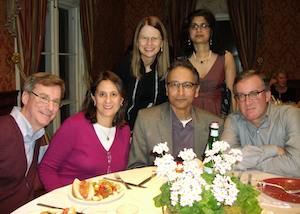
Back row: Sara Werder, Renu Lalwani
Front row: Seth and Susan Ross, Anil Lalwani, Richard Werder
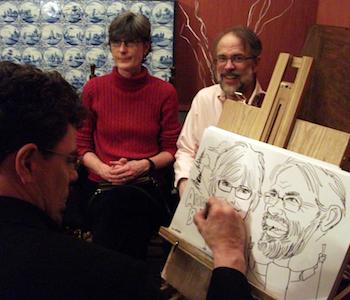 Anne Hintemeister and Bruce Wells in the artist alcove
Anne Hintemeister and Bruce Wells in the artist alcove
Photo credit: Lisa VanGundy
SHS Cheerleaders Headed to Nationals
- Details
- Hits: 3974
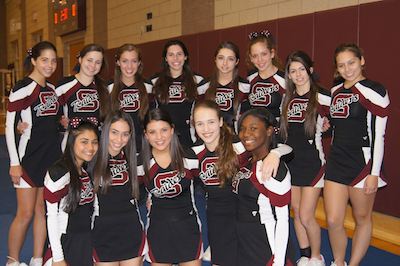 This year both the JV and Varsity Cheerleading teams have made it all the way to the National competition that will take place from February 11th to the 12th in Orlando, Florida. This is the first time since 2007 that both of the teams will be competing at Nationals together. After facing many injuries the team managed to work extra hard and accomplish their goal of qualifying for Nationals. Stacy Monteiro, the head of Cheerleading at SHS, was asked how she felt about this season, “I have to say with all of our set backs the teams remained so positive and motivated to never give up and continue moving forward. Although we have had many obstacles to overcome we were lucky enough to qualify for Nationals, returning for the Varsity teams 10th year.
This year both the JV and Varsity Cheerleading teams have made it all the way to the National competition that will take place from February 11th to the 12th in Orlando, Florida. This is the first time since 2007 that both of the teams will be competing at Nationals together. After facing many injuries the team managed to work extra hard and accomplish their goal of qualifying for Nationals. Stacy Monteiro, the head of Cheerleading at SHS, was asked how she felt about this season, “I have to say with all of our set backs the teams remained so positive and motivated to never give up and continue moving forward. Although we have had many obstacles to overcome we were lucky enough to qualify for Nationals, returning for the Varsity teams 10th year.
Mariah Genis, a senior and one of the captains of the Varsity team, says that the reason the team is doing so well this year is because of the bonds they have formed over the last two years. Most of the girls on the Varsity team have been together for two years now and Mariah says they have a great team dynamic.
When asked if she was nervous about competing at Nationals Mariah said: “I'm thrilled! To get a chance to compete with some of the best teams in the nation is amazing.” All of the 14 girls on Varsity and the 21 girls on JV will be traveling down south. Some parents and other family members will also be attending the tournament. The teams will be staying at the All Star Resort in Orlando. The competition will last for two days. During those two days the Varsity team will need to compete in two rounds to make it to the finals. They will first compete in the preliminary round and , depending on their performance, the Semifinals and will hopefully make it all the way to the final round. The JV team will only compete in one round at Nationals and will go straight to the Semifinal round. Both teams routines are put to an 80’s music soundtrack.
To qualify for Nationals the two teams had to compete at the Regional competition. The Regional competition was held at Hofstra University on December 5th. To prepare the teams dedicate a huge amount of time to practice. The Varsity and JV teams practice about five days a week for approximately two and a half hours a day. The official season is from fall to winter, but during the spring the teams participate in clinics and in try-outs. In the summer the teams spend a week at Pine Forest Cheer Camp in the Poconos to train for the upcoming season.
We are all cheering for the SHS cheerleaders!














